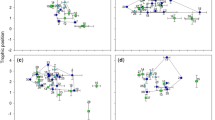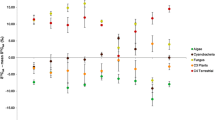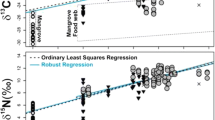Abstract
The advent of stable nitrogen isotope analysis in ecological research has at last enabled precise identification of trophic position and omnivory due to the differential enrichment of15N over14N with progressive assimilation up the foodweb. I compiled literature data on δ15N values in freshwater and marine foodwebs to search for qeneral patterns in omnivory, specifically the supposition originally proposed by Lindeman (1942) and most recently advanced by Peters (1977), that omnivory should increase with trophic height or position. Omnivory, measured as average intraspecific variability in δ15N, was indeed found to increase with trophic height, such that species at the top of foodwebs were comprised of animals relying, on average, on energy originating from a mixture of different trophic categories.
Similar content being viewed by others
References
Broman, D., C. Naf, C. Rolff, Y. Zebuhr, B. Fry and J. Hobbie (1992) Using ratios of stable nitrogen isotopes to estimate bioaccumulation and flux of polychlorinated dibenzo-p-dioxins (PCDDs) and dibenzofurans (PCDFs) in two food chains from the northern Baltic.Envrionmental Toxicology and Chemistry 11: 331–345.
Burns, T. P. (1989) Lindeman’s contradiction and the trophic structure of ecosystems.Ecology 70: 1355–1362.
Cabana, G. and J. B. Rasmussen (1994) Modelling food chain structure and contaminant bioaccumulation using stable nitrogen isotopes.Nature 372: 255–257.
Cabana, G. and J. B. Rasmussen(1996) Comparing aquatic food chains using nitrogen isotopes: the problem of anthropogenic15N enrichment.Proceedings of the National Academy of Science of the USA 93: 10844–10847.
Cousins, S. (1980) A trophic continuum derived from plant structure, animal size and a detritus cascade.Journal of theoretical Biology 82: 607–618.
Darnell, R. M. (1961) Trophic spectrum of an estuarine community, based on studies of Lake Pontchartrain, Louisiana.Ecology 42: 553–568.
DeMelo, R., R. France and D. J. McQueen (1992) Biomanipulation: hit or myth?Limnology and Oceanography 37: 192–207.
DeNiro, M. J. and S. Epstein (1981) Influence of diet on the distribution of nitrogen isotopes in animals.Geochimica et Cosmochimica Acta 45: 341–351.
Diehl, S. (1992) Fish predation and benthic community structure: the role of omnivory and habitat complexity.Ecology 73: 1646–1661.
Diehl, S. (1993) Relative consumer sizes and the strengths of direct and indirect interactions in omnivorous feeding relationships.Oikos 68: 151–157.
Diehl, S. (1995) Direct and indirect effects of omnivory in a littoral lake community.Ecology 76: 1727–1740.
Estep, M. L. and S. Vigg (1985) Stable carbon and nitrogen isotope tracers of trophic dynamics in natural populations and fisheries of the Lahonan Lake System, Nevada.Canadian Journal of Fisheries and Aquatic Sciences 42: 1712–1719.
France, R. (1992) The North American latitudinal gradient in species richness and geographical range of freshwater crayfish and amphipods.American Naturalist 139: 342–354.
France, R. L. (1994) Nitrogen isotopic composition of marine and freshwater invertebrates.Marine Ecology Progress Series 115: 205–207.
France, R. L. (1995a) Source variability in δ15N of autotrophs as a potential aid in measuring allochthony in freshwaters.Ecography 18: 318–320.
France, R. (1995b) Stable nitrogen isotopes in fish: literature synthesis on the influence of ecotonal coupling.Estuarine and Coastal Shelf Science 41: 737–742.
France, R. L. and R. H. Peters (1997) Ecosystem differences in13C enrichment in aquatic foodwebs.Canadian Journal of Fisheries and Aquatic Sciences 54: 1255–1258.
France, R. L., K. Westcott, P. del Giorgio, G. Klein and J. Kalff (1996) Vertical foodweb structure of freshwater Zooplankton assemblages estimated by stable nitrogen isotopes.Researches on Population Ecology 38: 283–287.
Goldwasser, L. and J. Roughgarden (1993) Construction and analysis of a large Caribbean food web.Ecology 74: 1216–1233.
Hall, S. J. and D. G. Raffaelli (1993) Food webs: theory and reality.Advances in Ecological Research 24: 187–239.
Havens, K. E., L. A. Bull, A. L. Warren, T. L. Crisman, E. J. Philips and J. P. Smith (1996) Food wed structure in a subtropical lake ecosystem.Oikos 75: 20–32.
Hunter, M. D. and P. Price (1992) Playing chutes and ladders: heterogeneity and the relative roles of bottom-up and top-down forces in natural communities.Ecology 73: 724–732.
Hutchinson, G. E. (1959) Homage to Santa Rosalia or why are there so many kinds of animals?American Naturalist 93: 145–159.
Kalff, J. (1996) Robert Henry Peters 1946–1996.Canadian Journal of Fisheries and Aquatic Sciences 53: 1692–1694.
Kercher, J. R. and H. H. Shugart (1975) Trophic structure, effective trophic position, and connectivity in food webs.American Naturalist 109: 191–206.
Kozlovsky, D. G. (1968) A critical evaluation of the trophic level concept 1. Ecological efficiencies.Ecology 49: 48–60.
Kling, G. W., B. Fry and W. J. O’Brien (1992) Stable isotopes and planktonic trophic structure in arctic lakes.Ecology 73: 561–566.
Lawton, J. H. (1992) Feeble links in food webs.Nature 355: 19–20.
Levine, S. (1980) Several measures of trophic structure applicable to complex food webs.Journal of theoretical Biology 83: 195–207.
Lindeman, R. L. (1942) The trophodynamic aspect of ecology.Ecology 23: 399–418.
Loehle, C. (1987) Hypothesis testing in ecology: psychological aspects and the importance of theory maturation.Quartenary Review of Biology 62: 397–409.
Martinez, N. D. (1991) Artifacts or attributes? effects of resolution on the Little Rock Lake food web.Ecological Monographs 61: 367–392.
Menge, B. and J. Sutherland (1987) Community regulation: variation in disturbance, composition, and predation in relation to environmental stress and recruitment.American Naturalist 130: 730–757.
Minagawa, M. and E. Wada (1984) Stepwise enrichment of15N along food chains: further evidence and the relation between15N and animal age.Geochimica et Cosmochimica Acta 48: 1135–1140.
Mullin, M. M., G. H. Rau and R. W. Eppley (1984) Stable nitrogen isotopes in Zooplankton: some geographic and temporal variations in the North Pacific.Limnology and Oceanography 29: 1267–1273.
Nurnberg, G. (1996) Robert H. Peters … a person we will greatly miss.Lakeline 16: 24.
Owens, N. J. P. (1987) Natural variations in15N in the marine environment.Advances in Marine Biology 24: 389–451.
Pace, M. L. and P. del Giorgio (1996) In memorium-Dr. Robert H. Peters.Marine Ecology Progress Series 142: 1.
Paine, R. T. (1980) Food webs: linkage, interaction strength and community infrastructure.Journal of Animal Ecology 49: 667–685.
Paine, R. T. (1988) Food webs: road maps of interactions or grist for theoretical development.Ecology 69: 1648–1654.
Paine, R. T. (1992) Food-web analysis through field measurement of per capita interaction strength.Nature 355: 73–75.
Paine, R. T. (1996) Preface, pp. xi-x.In Polis, G. A. and Winemiller, K. O. (eds.)Food webs. Integration of patterns and dynamics. Chapman and Hall, New York.
Peters, R. H. (1977) The unpredictable problems of trophodynamics.Environmental Biology of Fishes 2: 97–101.
Peters, R. H. (1988) Some general problems for ecology illustrated by food web theory.Ecology 69: 1673–1676.
Pimm, S. L. and J. H. Lawton (1978) On feeding on more than one trophic level.Nature 275: 542–544.
Polis, G. A. (1991) Complex trophic interactions in deserts: an empirical critique of food wed theory.American Naturalist 138: 123–155.
Rigler, F. H. (1975) The concept of energy flow and nutrient flow between trophic levels, pp. 15–26. In Dobben, W. H. and R. H. Lowe-McConnell (eds.)Unifying concepts in ecology. Junk Publ., The Hague.
Schoener, T. W. (1989) Food webs from the small to the large.Ecology 70: 1559–1589.
Sprules, W. G. and J. E. Bowerman (1988) Omnivory and food chain length in Zooplankton food webs.Ecology 69: 483–499.
Stevens, G. C. (1989) The latitudinal gradient in geographical range: how so many species coexist in the tropics.American Naturalist 133: 240–256.
Ulanowicz, R. E. and W. E. Kemp (1979) Toward canonical trophic aggregations.American Naturalist 114: 871–883.
Vadas, R. L. (1990) The importance of omnivory and predator regulation of prey in freshwater fish assemblages of North America.Environmental Biology of Fishes 27: 285–302.
Vander Zanden, M. J. and J. B. Rasmussen (1996) A trophic position model of pelagic food webs: impact on contaminant bioaccumulation in lake trout.Ecological Monographs 66: 451–477.
Vander Zanden, M. J., G. Cabana and J. B. Rasmussen (1997) Comparing trophic positon of freshwater fish calculated using stable nitrogen isotope ratios (δ15N) and literature dietary data.Canadian Journal of Fisheries and Aquatic Sciences 54: 1142–1158.
Warren, P. H. (1989) Spatial and temporal variation in the structure of a freshwater food web.Oikos 55: 299–311.
Warren, P. H. (1995) Estimating morphologically determined connectance and structure for food webs of freshwater invertebrates.Freshwater Biology 33: 213–221.
Winemiller, K. O. (1990) Spatial and temporal variation in tropical fish trophic networks.Ecological Monographs 60: 331–367.
Yoshioka, T., E. Wada and H. Hayashi (1994) A stable isotope study on seasonal food web dynamics in a eutrophic lake.Ecology 75: 835–846.
Yodzis, P. (1984) Energy flow and the vertical structure of real ecosystems.Oecologia 65: 86–88.
Author information
Authors and Affiliations
Corresponding author
Rights and permissions
About this article
Cite this article
France, R.L. δ15N examination of the Lindeman-Hutchinson-Peters theory of increasin omnivory with trophic height in aquatic foodwebs. Res Popul Ecol 39, 121–125 (1997). https://doi.org/10.1007/BF02765257
Received:
Accepted:
Issue Date:
DOI: https://doi.org/10.1007/BF02765257




